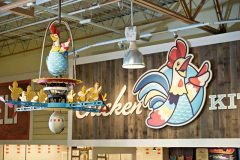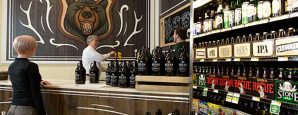Last updated on January 15th, 2019 at 08:33 am
Tim Lowe, president of North Carolina-based Lowes Foods, was a featured speaker at the Grocery Manufacturers Association (GMA) Leadership Forum in August in Colorado Springs. Lowe was among the speakers invited to share their strategies and collaboration opportunities.
Lowe oversees a locally owned (by Alex Lee Inc.) and operated grocery company comprising nearly 100 full-service supermarkets in North Carolina, South Carolina and Virginia.
Tim Lowe—who is not directly related to the company’s founders nor owns the company though he carries the name—has been with the company for five years and has overseen a transformation over the past four years that has as its goal keeping customers excited about shopping at Lowes stores—especially in the face of all the competition out there, not just from other brick-and-mortar retailers but also from myriad e-commerce sources as well.
“We’re constantly asking, ‘how can we reinvent ourselves?’” Lowe said.
The first Lowes retail food store opened in 1954, he said, and the company evolved over the decades, updating its company logo and product offerings as trends dictated, and the company was doing fine. When Tim Lowe joined the company, he brought with him the idea of doing ethnographic visits—going into people’s homes not as representing Lowes Foods but as an impartial observer—and talking with them about the places they shop and why they like shopping there (a $50 gift card was offered for their time). They were asked, “tell us about Lowes Foods.”
“They would say, ‘Lowes Foods, we like them fine. They’re convenient and clean and that kind of thing but, you know, we feel kind of neutral about them.’ Well, we looked at that as being a pretty dangerous place, so we started on a journey to go through and rebrand who we are.”
The first store to get the rebranding was in Clemmons, North Carolina, and it opened on a 7-degree day in January 2014.
That store was the result of a year’s work, developing some innovative merchandising plans and remodeling the store to reflect those plans. Many of the ideas for the store were borne out of a 24-hour work session for the management team.
“About 2 or 3 o’clock in the morning, you would be surprised at some of the ideas that come out of people’s heads,” Lowe said. “There were people doing chicken dances, dancing around with sausage hats—and that is not a lie. We wanted to break down all these barriers; we wanted to think differently about grocery—how do we go to places that other people won’t go? And how do we create a different experience for folks within the shopping experience?”
While “local,” “inspirational” and “passionate about food” were some of the values the group came up with, there’s another one—wit.
“How many of you have ever been into a grocery store where you’ve actually seen a chicken chandelier? And how many of you have ever been somewhere that when they pull the fresh rotisserie chickens out of the oven—that’s had no antibiotics ever, locally raised and harvested right there in Carolinas—that the employees actually get together and they do a chicken dance?
“Well, if you haven’t, you haven’t been to Lowes Foods, because the thing that we know is that it’s really all about the experience.”
And that experience leads to sales.

“We started doing this chicken dance, our sales lift wasn’t just 20 percent, it wasn’t 40 percent; it was actually 120 percent in a very mature category. I’m like, ‘hold on, that math is crazy math and it just doesn’t work. I don’t think it’s repeatable, so let’s do it again.’ So, we went to another store and we added another Chicken Kitchen and guess what? It’s happened again and again and again.”
So, the Chicken Kitchen was launched across the entire company. And while not many customers join in the chicken dance (unless they’re kids), many do like to record it on their smartphones and then post it to social media, which “gave us all kinds of advertising right there on the spot.”
The success of the Chicken Kitchen led to Lowes trying out more out-of-the box ideas.
Lowes’ in-store sous chefs are available to prep produce for shoppers who can’t find exactly what they’re looking for in the produce department.
“We said what if we could slice, dice, chop, julienne, do whatever you want with your produce while you wait or do your shopping? If you want organic onion vs. a regular onion, we’ll do it for you. If you want it chopped or cut up a certain way, we’ll take care of it for you. We’ll take that service to you right there before you leave, right there on the spot,” Lowe said.
The Beer Den is another example of going to pretty great lengths to provide a new experience for shoppers. Lowes began working in 2013 to get laws changed that would allow its stores to serve beer in growlers and was successful. Today, customers can buy 32- and 64-oz. growlers to take home.
“What do you get when you cross a bear and a deer? You get a beer. That’s why I call it The Beer Den, and that’s why our logo is a bear with antlers,” Lowe said—another example of the wit shoppers have come to expect from Lowes Foods.

With more lobbying to expand alcohol sales, Lowes stores now are able to serve beer and wine by the glass for shoppers to enjoy while shopping or just hanging out.
Taking it even one step further, Lowes decided to brew some of its own beer. So it opened a store in Simpsonville, South Carolina, just outside of Greenville, with its own brewery. It has its own brewmaster, who is “just fantastic,” Lowe says. “There are all kinds of unique, crazy brews.”
There’s Jack and the Wheatstalk, for instance.
The brewery makes eight of its own beers and then offers eight other brews from local breweries in and around Simpsonville, so there are 16 offered at all times, vs. about eight at other stores.
In the deli, the Sammy’s sandwich makers wear fake mustaches, which sometimes show up in other places in the store.
“There’s always hidden gems in all these things that we do,” Lowe said.
“That’s just a small snippet of who Lowes Foods is,” he added. “That’s only three concepts. The last store we just remodeled, we opened with 15 concepts. We continue to iterate; we are on our 3.0 version of who we are because the thing is, we know that we’ve got to continue to move forward as an organization. We cannot be stagnant because you know change is the law of life, and those who look only to the past or the present are certain to miss the future.”
Speaking of the future, Lowe said his company expects to do about $42 million in e-commerce sales through its Lowes Food-To-Go program this coming year, “but we expect it to continue to grow.
“It’s my fastest growing channel—it has been for the last four years. I expect it will be about a $200 million business for me by the year 2025,” he said. “We are making sure that we have plans, just like we’ve done with our retail stores, to make sure that we are embracing this.”
Keep reading:
Food Lion Partners With Church, Food Bank To Aid Thousands Impacted By Florence
Dollar Tree Consolidating North Carolina & Virginia Store Support Centers






